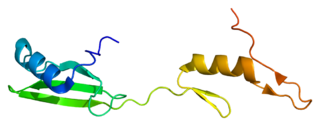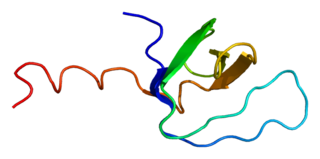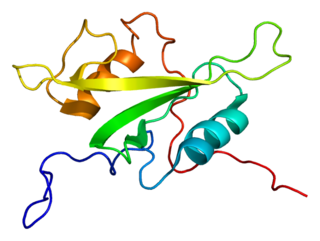Signal-transducing adaptor protein 1 is a protein that in humans is encoded by the STAP1 gene. [5] [6] [7]
Signal-transducing adaptor protein 1 is a protein that in humans is encoded by the STAP1 gene. [5] [6] [7]
The protein encoded by this gene functions as a docking protein acting downstream of Tec tyrosine kinase in B cell antigen receptor signaling. The protein is directly phosphorylated by Tec in vitro where it participates in a positive feedback loop, increasing Tec activity. A mouse ortholog, stem cell adaptor protein 1, shares 83% identity with its human counterpart. [7]

Signal transducing adaptor proteins (STAPs) are proteins that are accessory to main proteins in a signal transduction pathway. Adaptor proteins contain a variety of protein-binding modules that link protein-binding partners together and facilitate the creation of larger signaling complexes. These proteins tend to lack any intrinsic enzymatic activity themselves, instead mediating specific protein–protein interactions that drive the formation of protein complexes. Examples of adaptor proteins include MYD88, Grb2 and SHC1.

Tyrosine-protein kinase ITK/TSK also known as interleukin-2-inducible T-cell kinase or simply ITK, is a protein that in humans is encoded by the ITK gene. ITK is a member of the TEC family of kinases and is highly expressed in T cells.

CD5 is a cluster of differentiation expressed on the surface of T cells and in a subset of murine B cells known as B-1a. The expression of this receptor in human B cells has been a controversial topic and to date there is no consensus regarding the role of this receptor as a marker of human B cells. B-1 cells have limited diversity of their B-cell receptor due to their lack of the enzyme terminal deoxynucleotidyl transferase (TdT) and are potentially self-reactive. CD5 serves to mitigate activating signals from the BCR so that the B-1 cells can only be activated by very strong stimuli and not by normal tissue proteins. CD5 was used as a T-cell marker until monoclonal antibodies against CD3 were developed.

The Linker for activation of T cells, also known as linker of activated T cells or LAT, is a protein which in humans is encoded by the LAT gene. Alternative splicing results in multiple transcript variants encoding different isoforms.

Non-receptor tyrosine-protein kinase TYK2 is an enzyme that in humans is encoded by the TYK2 gene.

RAC-beta serine/threonine-protein kinase is an enzyme that in humans is encoded by the AKT2 gene.

Crk-like protein is a protein that in humans is encoded by the CRKL gene.

GRB2-associated-binding protein 1 is a protein that in humans is encoded by the GAB1 gene.

Docking protein 1 is a protein that in humans is encoded by the DOK1 gene.

Cytoplasmic protein NCK1 is a protein that in humans is encoded by the NCK1 gene.

Suppressor of cytokine signaling 1 is a protein that in humans is encoded by the SOCS1 gene. SOCS1 orthologs have been identified in several mammals for which complete genome data are available.

Tyrosine-protein kinase Tec is an enzyme that in humans is encoded by the TEC gene.

Docking protein 2 is a protein that in humans is encoded by the DOK2 gene.

LIM and senescent cell antigen-like-containing domain protein 1 is a protein that in humans is encoded by the LIMS1 gene.

SH2B adapter protein 2 is a protein that in humans is encoded by the SH2B2 gene.

Tyrosine-protein kinase TXK is an enzyme that in humans is encoded by the TXK gene.

Dual adapter for phosphotyrosine and 3-phosphotyrosine and 3-phosphoinositide is a protein that in humans is encoded by the DAPP1 gene.

Signal-transducing adaptor protein 2 is a protein that in humans is encoded by the STAP2 gene.

5-azacytidine-induced protein 2 is a protein that in humans is encoded by the AZI2 gene.

Phosphoinositide 3-kinase regulatory subunit 4, also known as PI3-kinase regulatory subunit 4 or PI3-kinase p150 subunit or phosphoinositide 3-kinase adaptor protein, or VPS15 is an enzyme that in humans is encoded by the PIK3R4 gene.
| This article on a gene on human chromosome 4 is a stub. You can help Wikipedia by expanding it. |